AMD’s 5 GHz Turbo CPU in Retail: The FX-9590 and ASRock 990FX Extreme9 Review
by Ian Cutress on August 9, 2014 8:00 AM ESTMany thanks to...
We must thank the following companies for kindly providing hardware for our test bed:
Thank you to OCZ for providing us with PSUs and SSDs.
Thank you to G.Skill and ADATA for providing us with memory kits.
Thank you to Corsair for providing us with an AX1200i PSU, Corsair H80i CLC and DRAM.
Thank you to ASUS for providing us with the AMD HD7970 GPUs and some IO Testing kit.
Thank you to MSI for providing us with the NVIDIA GTX 770 Lightning GPUs.
Thank you to Rosewill for providing us with PSUs and RK-9100 keyboards.
Thank you to ASRock for providing us with some IO testing kit.
Test Setup
| Test Setup | |
| Processor |
AMD FX-9590 4 Modules, 8 Threads, 4.7 GHz, 5.0 GHz Turbo |
| Motherboards | ASRock 990FX Extreme9 |
| Cooling |
Corsair H80i Thermalright TRUE Copper |
| Power Supply |
OCZ 1250W Gold ZX Series Corsair AX1200i Platinum PSU |
| Memory | G.Skill RipjawsZ 4x4 GB DDR3-1866 9-11-9 Kit |
| Memory Settings | DDR3-1866 8-9-9 |
| Video Cards | MSI GTX 770 Lightning 2GB (1150/1202 Boost) |
| Video Drivers | NVIDIA Drivers 337 |
| Hard Drive | OCZ Vertex 3 256GB |
| Optical Drive | LG GH22NS50 |
| Case | Open Test Bed |
| Operating System | Windows 7 64-bit SP1 |
| USB 2/3 Testing | OCZ Vertex 3 240GB with SATA->USB Adaptor |
| WiFi Testing | D-Link DIR-865L 802.11ac Dual Band Router |
System Benchmarks
Power Consumption
Power consumption was tested on the system as a whole with a wall meter connected to the OCZ 1250W power supply, while in a single MSI GTX 770 Lightning GPU configuration. This power supply is Gold rated, and as I am in the UK on a 230-240 V supply, leads to ~75% efficiency > 50W, and 90%+ efficiency at 250W, which is suitable for both idle and multi-GPU loading. This method of power reading allows us to compare the power management of the UEFI and the board to supply components with power under load, and includes typical PSU losses due to efficiency. These are the real world values that consumers may expect from a typical system (minus the monitor) using this motherboard.
While this method for power measurement may not be ideal, and you feel these numbers are not representative due to the high wattage power supply being used (we use the same PSU to remain consistent over a series of reviews, and the fact that some boards on our test bed get tested with three or four high powered GPUs), the important point to take away is the relationship between the numbers. These boards are all under the same conditions, and thus the differences between them should be easy to spot.
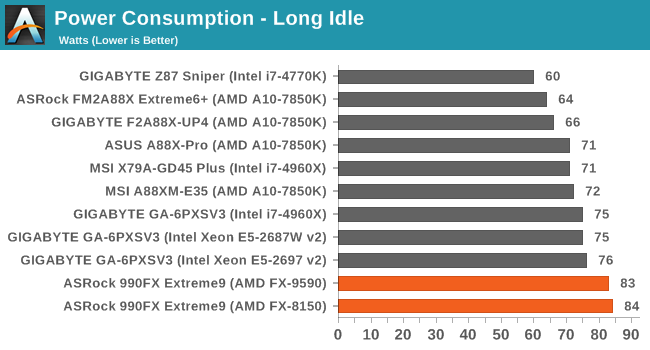
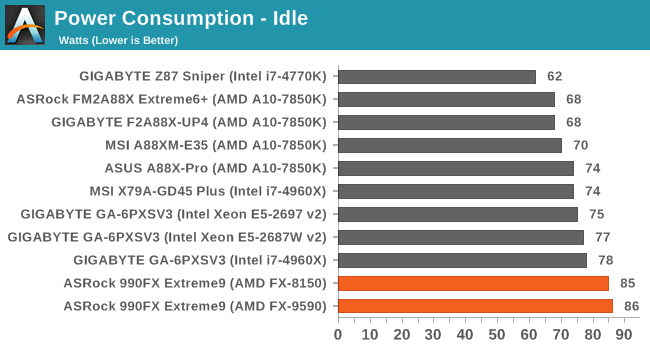
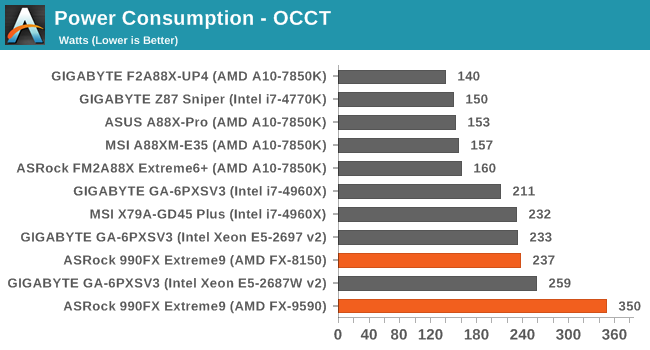
The added power draw of the FX-9590 is quite clear, showing 350W for the full system during a heavy CPU load. However, the idle power draw of the CPU is similar to that of the FX-8150.
Windows 7 POST Time
Different motherboards have different POST sequences before an operating system is initialized. A lot of this is dependent on the board itself, and POST boot time is determined by the controllers on board (and the sequence of how those extras are organized). As part of our testing, we are now going to look at the POST Boot Time - this is the time from pressing the ON button on the computer to when Windows 7 starts loading. (We discount Windows loading as it is highly variable given Windows specific features.) These results are subject to human error, so please allow +/- 1 second in these results.
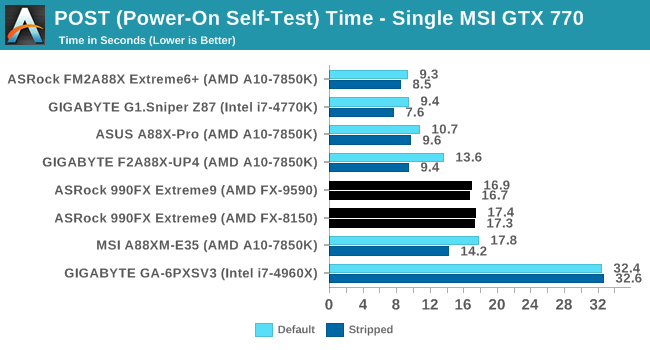
The FX-9590 afforded a shorter POST time than the FX-8150, although both are north of 16 seconds.
Rightmark Audio Analyzer 6.2.5
The premise behind Rightmark:AA is to test the input and output of the audio system to determine noise levels, range, harmonic distortion, stereo crosstalk and so forth. Rightmark:AA should indicate how well the sound system is built and isolated from electrical interference (either internally or externally). For this test we connect the Line Out to the Line In using a short six inch 3.5mm to 3.5mm high-quality jack, turn the OS speaker volume to 100%, and run the Rightmark default test suite at 192 kHz, 24-bit. The OS is tuned to 192 kHz/24-bit input and output, and the Line-In volume is adjusted until we have the best RMAA value in the mini-pretest. We look specifically at the Dynamic Range of the audio codec used on board, as well as the Total Harmonic Distortion + Noise.
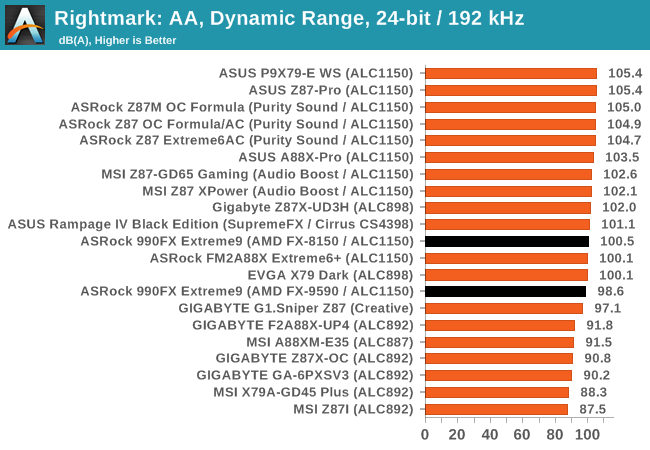
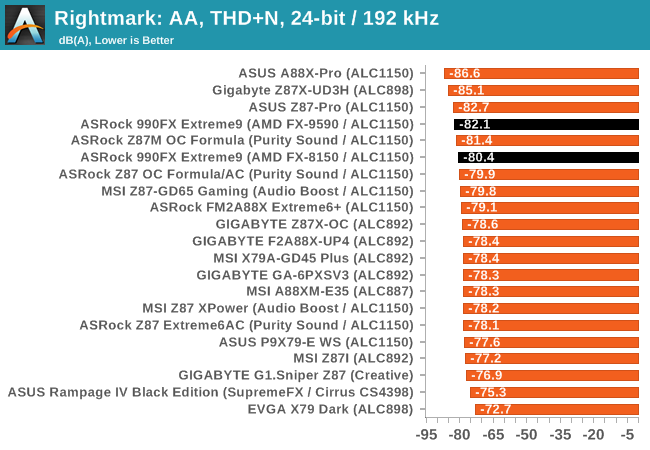
USB Backup
For this benchmark, we run CrystalDiskMark to determine the ideal sequential read and write speeds for the USB port using our 240 GB OCZ Vertex3 SSD with a SATA 6 Gbps to USB 3.0 converter. Then we transfer a set size of files from the SSD to the USB drive using DiskBench, which monitors the time taken to transfer. The files transferred are a 1.52 GB set of 2867 files across 320 folders – 95% of these files are small typical website files, and the rest (90% of the size) are the videos used in the WinRAR test. In an update to pre-Z87 testing, we also run MaxCPU to load up one of the threads during the test which improves general performance up to 15% by causing all the internal pathways to run at full speed.
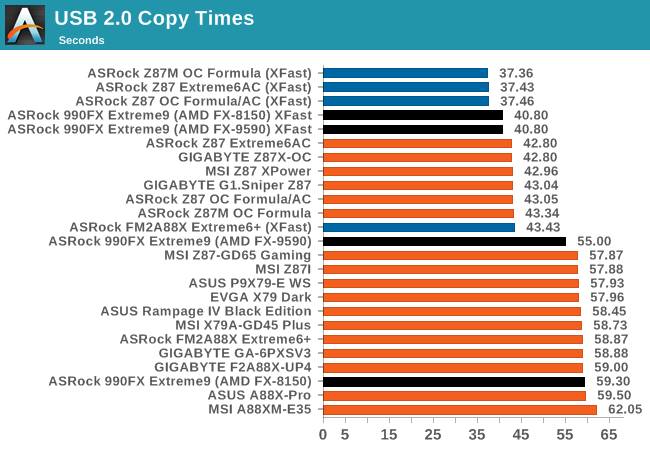
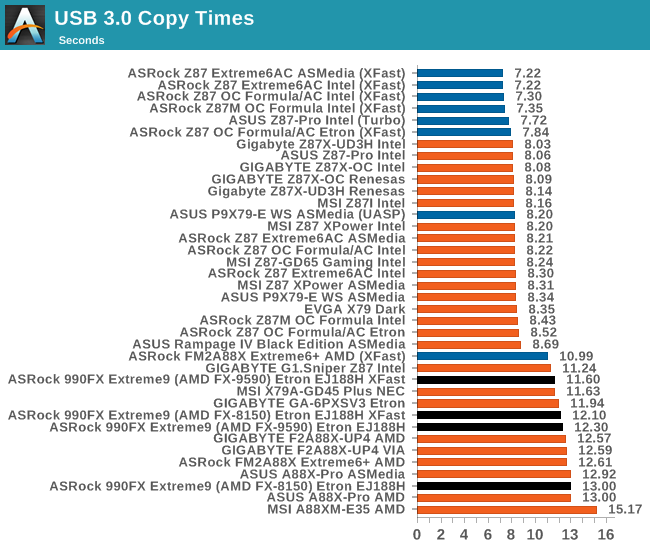
The increase in CPU speed of the FX-9590 gives a measured improvement in standard USB copy times – saving 4.3 seconds over the FX-8150 for USB 2.0 transfers. However using XFast USB eliminated that difference completely. For USB 3.0 transfers, using the Etron controller put a consistent advantage on the side of the FX-9590.
DPC Latency
Deferred Procedure Call latency is a way in which Windows handles interrupt servicing. In order to wait for a processor to acknowledge the request, the system will queue all interrupt requests by priority. Critical interrupts will be handled as soon as possible, whereas lesser priority requests, such as audio, will be further down the line. So if the audio device requires data, it will have to wait until the request is processed before the buffer is filled. If the device drivers of higher priority components in a system are poorly implemented, this can cause delays in request scheduling and process time, resulting in an empty audio buffer – this leads to characteristic audible pauses, pops and clicks. Having a bigger buffer and correctly implemented system drivers obviously helps in this regard. The DPC latency checker measures how much time is processing DPCs from driver invocation – the lower the value will result in better audio transfer at smaller buffer sizes. Results are measured in microseconds and taken as the peak latency while cycling through a series of short HD videos - less than 500 microseconds usually gets the green light, but the lower the better.
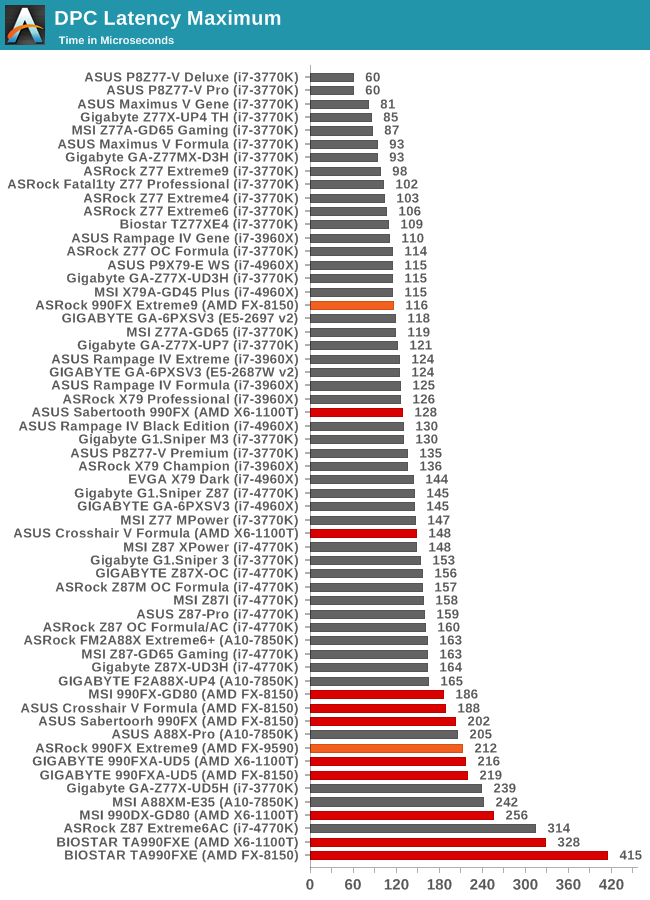
In a surprising twist, it would seem the FX-9590 has a disadvantage for DPC latency. I would have expected the faster processor to have the lower result, but one might speculate that the BIOS is tuned more for the mainstream processors such as the FX-8150. The chipset might also be geared more to the FX-8150 as it was the earlier generation compared to the FX-9590.










146 Comments
View All Comments
RussianSensation - Sunday, August 10, 2014 - link
The motherboard in the review is $170 not $250. But yes it's a lot better to buy an i5-7 than this chip.edwd2 - Saturday, August 9, 2014 - link
Will we be getting new FX chips in the future?or is it just APUs ...
Mrduder11 - Saturday, August 9, 2014 - link
I am not highly invested in either "camp" but I will say this is absolutely embarrassing for AMD. As a gamer, I could never justify purchasing this CPU when using with a dedicated graphics setup. The results show AMD's way off the mark in research and development in their GPU labs.RussianSensation - Sunday, August 10, 2014 - link
Has little to do with research and development. You can't expect a 28-32nm CPU to compete with a 22nm CPU no matter how hard you try. It would be akin to NV having 28nm GTX780Ti going up against a 40nm HD6970. AMD's biggest problem is no access to the same lithography tech as Intel.mapesdhs - Tuesday, August 12, 2014 - link
Actually it has a lot to do with R&D. An ex-AMD employee said a few years ago thatAMD's big mistake was making extensive use of automated design tools, resulting
in a 3rd more transistors, using more power, for less performance. Presumably this
was cheaper than paying the required talent to do the fine tuning normally expected
at this level. Either way, this is why BD was so bad, and they've never recovered.
AMD simply doesn't have the money to do the base R&D, that's the key blockage.
Ian.
Budburnicus - Wednesday, January 14, 2015 - link
Umm, the i5-2500k AND i7-2600K are 32nm CPU's and even at a 4.7 GHz overclock do not even draw HALF the power and are over TWICE as fast! All from a 3 year old SKU!The cherry on top of the pile of dog poop would HAVE to be the fact that AMD had to make an R9 290 with a 512 bit memory bus to TRY to keep up with Nvidia's 970 or 980 - and that GPU takes over twice the power as well!
So YES this has EVERYTHING to do with R&D! Both their CPUs and GPUs are HORRIBLY inefficient!
And again, process has little to do with it, bearing in mind that the 32nm i-cores are not only 3 years old, but draw well less than HALF the power, and still over 1/3 less at the same 4.7 GHz clock speed, except when an i7-2600K is running at that speed, it is FAR FASTER in EVERY way!
TeXWiller - Saturday, August 9, 2014 - link
Who knows, Kaveri brought the three module support for the APUs. The devil is the implementation details and timing. I was little disappointed when they took out the remaining 95W four module chips from the channel.TiGr1982 - Saturday, August 9, 2014 - link
What do you mean by "three module support for the APUs"? Talking about CPU side of things, all the APUs since Trinity only have 2 CPU modules aka 4 AMD cores. More than that, staying with this Bulldozer-derived CPU tech, APUs won't get more than 2 modules because of the die area and associated TDP and cost issues.TeXWiller - Saturday, August 9, 2014 - link
See http://support.amd.com/TechDocs/49125_15h_Models_3... page 28TiGr1982 - Saturday, August 9, 2014 - link
OK,"2 or 3 core-pairs Add 3 CU support."
But there is no 3 "core-pair" (3 CU, 3 modules) Kaveri APUs on the market - at least, as of yet.